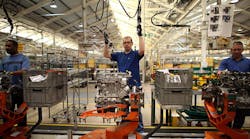Three months down, one month back up for domestic industrial production, which increased 0.9% in January according to the Federal Reserve, with manufacturing close behind thanks to a 0.5% increase.
Many of the struggles of the last quarter were blamed on the mild winter weather — utility production alone jumped 5.4% thanks to colder weather in January — along with the appreciating dollar, the plummeting price of oil and disappointing export demand.
“Manufacturing activity remains softer than desired, particularly given difficulties in growing export demand and with falling commodity prices,” National Association of Manufacturers chief economist Chad Moutray said.
Moutray noted that manufacturing output has increased 1.2% during the last 12 months, better than the 0.5% bump during the year preceding that but still “slowed considerably since January 2015, when the year-over-year rate was a more-robust 4.3%.”
Both durable goods and nondurable goods production were up in January — 0.5% and 0.4%, respectively — with the most significant increases in motor vehicles and parts (up 2.8%, but still down 4.8% since a big July) and primary metals (up 2.1%). In all, nine of the 20 major manufacturing industries bumped up production in the month. Industrial production overall has dropped 0.7% the last 12 months, in large thanks to mining (down 9.8% year over year) and utilities (down 2.8%).
“The January report shows that the manufacturing sector is able to grow amid the turmoil in emerging economies and the energy market collapse,” MAPI Foundation chief economist Daniel J. Meckstroth said. “We expect to see many ups and downs in manufacturing production this year. Manufacturing production is expected to grow only a modest 1.1% in 2016, which is slower than the 2.2% growth expected in the economy as a whole.”
The January report was economics writ small, to hear Meckstroth break it down.
“Consumers are expanding their purchases of motor vehicles, which benefits the automotive supply chain,” he said. “And the population is forming new households at a faster rate, which propels the robust housing market. The improvement in residential construction drives community development in the form of commercial construction. Infrastructure needs have led to a modest pace of public works construction expansion.”
Plenty of challenges still remain, obviously. The decline in metal and agricultural commodity prices, along with those depressed oil prices, are all adversely affecting machinery and metals. The threat of a technical recession — at least six months of cumulative real production decline — also looms.
The “strong January monthly performance was not enough to lift the super sector out of technical recession, largely because all revisions back to October were downgrades,” said analyst Alan Tonelson, who covers manufacturing and the economy on his RealityChek blog. “December’s initially reported 0.11% sequential monthly gain is now judged to be a 0.24% loss. November’s already downwardly revised 0.49% decrease is now pegged at 0.69%, and October’s already lowered 0.53% monthly growth was cut again to 0.49%.”
Durable goods annual output gains: also depressed, Tonelson said. The full-year 2015 0.49% constant dollar production increase has now been revised to a fractional decline — its worst such performance since its 5.26% drop in recessionary 2009. Between 2014 and 2015, real durable goods output increased by 5.36%.




